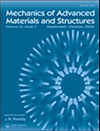The central aim of Mechanics of Advanced Materials and Structures is to promote the dissemination of significant developments and publish state-of-the-art reviews and technical discussions of previously published papers dealing with mechanics aspects of advanced materials and structures. Refereed contributions describing analytical, numerical and experimental methods and hybrid approaches that combine theoretical and experimental techniques in the study of advanced materials and structures will be published along with critical surveys of the literature and discussions of papers in the field. Contributions will range from new theories and formulations to analyses and novel applications. Emphasis will be placed on mechanics aspects and aspects at the interface of materials and mechanics issues. The journal will publish manuscripts dealing with the mechanics aspects (for example, the mechanical characterization, mathematical modeling, novel applications, and numerical simulation) of advanced materials and structures. Contributions may range from new methods to novel applications of existing methods to gain understanding of the material and/or structural behavior of new and advanced. Typical topic areas are: Materials Adhesives, ceramics, metal-matrix composites, and polymer-based composites; processing and manufacturing of composite; actuator/sensor (smart) materials and electromagnetic materials; and damage and failure mechanisms in material; Structures Basic structural elements such as beams, plates, and shells; structures with actuators/sensors (smart structures); active and passive control of structures; aerospace, automotive, and underwater structures; and adhesively bonded structures. Methodologies Mathematical formulation of the kinematic, constitutive, and structural behavior of materials and structures; experimental methods directed toward mechanical characterization, damage evolution, and failures in materials and structures; computational methods for the solution of micro-, meso-, macro-mechanics mathematical models; methods dealing with the determination of local effects; and novel computational approaches for material and structural modeling of new and advanced materials.
